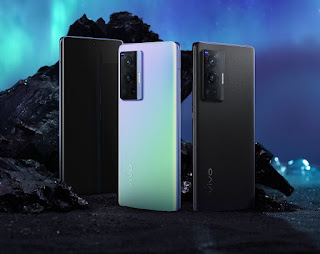Vivo X70 Pro is one of the upper-middle-class phones on the market. First impression, the size is quite large 6.56 inches with a weight of 186g. The screen is bright and the edges are slightly curved downwards giving it a wide and luxurious feel.
Like modern phones, the Vivo X70 Pro has various camera modules that can be used for various conditions. The main camera has a maximum resolution of 50MP with a wide lens, around 26mm f/1.8 aperture. The sensor used is 1/1.56" not the biggest but better than most existing camera phones.
The other camera module is the 16mm equivalent ultrawide, with a 12MP sensor, 1/3.1 and f/2.2 aperture. This camera is suitable for recording very wide landscapes or architecture.
Next there is a camera with a standard lens module, which is 50mm equivalent with a 12MP sensor, 1/2.93" and an f/2 lens. In my opinion, this camera module is unnecessary because it can be covered with digital zoom/crop from the main camera.
A telephoto camera is also available on this camera, using periscope zoom technology up to 60x so that the size of the phone remains flat. This camera has a sensor resolution of 8MP, 1/4.4" with an aperture of f/3.4 and an equivalent focal length of 125mm.
In making the lenses, Vivo collaborated with Zeiss which coats the lens elements with Zeiss' famous T* coating to prevent flare and keep photos sharp and bright in various light conditions, including backlight. Zeiss was also involved in developing the image processing for the bokeh backgrounds.
The images produced by these various camera modules are on average bright, sharp and some people will like. The best and detail is produced by the main camera module which is wide-lensed.
In good lighting conditions, the ultrawide camera module (0.6x zoom) produces images that are just as good as the main camera. This ultrawide module is especially attractive for very wide landscapes and architectures where the main lens is not wide enough. For its standard 2x zoom lens, it is suitable for detailed photos or portraits.
The photos from this camera are viewed from the VIVO cellphone monitor screen by default, bright colors and sharp, most people will like it and no editing is needed anymore. Shooting against the light is also still good thanks to the Zeiss coating. Only at certain angles can appear flare, but not significantly.
If we look at large monitors such as laptops or PC monitors with 100% magnification, the image details are not as good as compared to DSLR/mirrorless cameras with large sensors.
For the telephoto zoom module, due to the small sensor size and moderate aperture, the photos are not as good as other camera modules.
The photos are sharp but lack detail, for example, facial textures are not visible, and at 60x zoom, the writing from a distance is not clear even though it can still be read.
For portrait mode, we can choose a Zeiss lens-style bokeh simulation such as Biotar, Planar, Sonnar, and Distagon. Ideally, the chosen background has small but many light sources, such as decorative lights, or sunlight entering through the gaps in the leaves. This result at first glance can fool people who see it like using a Zeiss lens even though it is only processing via software.
For its video features, Vivo was one of the first phone manufacturers to implement gimbal stabilization and gyro-EIS to produce smooth video images when the camera is moving. The video results on the main and ultrawide camera modules look smooth and stable when the camera is still or moving.
Recommendation
As an upper middle class cellphone, VIVO PRO is suitable for friends who want to capture holiday moments both for photos and videos. The uniqueness of this VIVO is in the Zeiss coating which makes the photo look sharp and bright, the portrait photos can be adjusted with the bokeh style, and the video stability.
Because the video also supports 4K and FULL HD video recording with the EIS gyro, it is also suitable for friends who like to create video content on social media.

